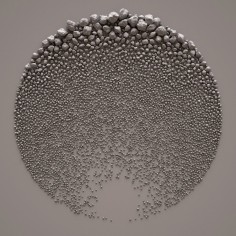GIUSEPPE RANDAZZO
ДЖУЗЕППЕ РАНДАЦЦО
generative stone fields

source: goooodhk
艺术家Giuseppe Randazzo利用算法生成演变型三维对象,而后再对其进行渲染得成的作品。结果
是迷人的,富有静谧感的石头景观。通过这种艺术手段和方式得到一个具有极大反差的富有永恒感
的作品,这有些讽刺意味。或许这是一种“偷懒”的方式,创作排列这些虚拟的石材,并赋予精神的力
量,同时在此过程中出现了与大地景观的一种联系,从开始无序的“自然”碎片(真正岩石/虚拟岩
石)影响(作者/软件)到你的环境(真实/位图),这也许已变成真正自然。
用细分策略将这些虚拟石头在圆圈中排布到适合位置,用混合代码驱动以促成石块的大小与密度。
这是一个C++代码,输出的是OBJ3d文件。最后的渲染,其目的不是让这些石块看起来有多真实,
而是让他们具有一个稳定的色彩,介于真实与抽象之间。
.
.
.
.
.
.
.
source: grafodgblogspot
Ya en 2009, el diseñador italiano Giuseppe Randazzo de Novastructura lanzó una serie de “esculturas” digitales generativos que representaban guijarros y rocas cuidadosamente organizados en una superficie plana. Bajo el título de Piedra Los campos , las obras fueron inspiradas en parte por piezas similares de la técnica de la tierra del escultor Inglés Richard Long . Como las imágenes difundidas en la web (pre-dating esta publicación completamente), muchas personas fueron algo descorazonado aprender las imágenes fueron creadas con el software en lugar de pinzas, un testimonio de C ++ habilidades de programación de Randazzo se utiliza para crear una aplicación personalizada que dictó archivos 3D basados en un número de parámetros.
Un avance rápido hasta 2014, y la tecnología finalmente ha alcanzado a la visión original de Randazzo. El diseñador se asoció recientemente con Shapeways para crear prototipos físicos de la Piedra Camposproyecto. Él comparte sobre el proceso:
A partir de 2009 el proyecto “Piedra Fields”, algunos archivos 3D se producen a partir de las mallas originales. La conversión fue bastante difícil, los modelos iniciales no fueron creados con 3dprinting en mente. El manejo de millones de triángulos y la comprobación de errores requiere un proceso complejo. Cada modelo es de 25 cm x 25 cm de ancho y fue producido por Shapeways en poliamida (blanco fuerte y flexible). Posteriormente fueron pintadas con aerógrafo. […] Fueron, con mucho, demasiado pequeños para ser impresos Los detalles minuciosos de las mallas originales, sin embargo a pesar de la pequeña escala, estos prototipos dan una idea de la complejidad de los gradientes de piedras artificiales.
.
.
.
.
.
.
.
source: liveinternetru
Giuseppe Randazzo, вдохновленный работами британского художника Richard Long, который заполняет одинокие пейзажи каменными образцами, создал свои 3d скульптуры. Он признает, что его версия более простая и ленивая.
.
.
.
.
.
.
.
source: novastructuranet
This project has started from a search for a 3d-objects optimal packing algorithm over a surface, but evolved in something rather different. I love the work by Richard Long, from which this project takes its cue. The way he fills lonely landscapes with arcaic stones patterns and its eroic artistic practice, in his monumental vision, is in strong contrast with this computational approach that – ironically – allows virtual stones creation and sorting in a non phisical, mental way, a ‘lazy’ version, so to speak. The virtual stones created from several fractal subdivision strategies, find their proper position within the circle, with a trial and error hierarchical algorithm. A mix of attractors and scalar fields (some with Perlin noise) drives the density and size of the stones. The code is a C++ console application that outputs a OBJ 3d file.
.
.
.
.
.
.
.
source: thisiscolossal
Back in 2009, Italian designer Giuseppe Randazzo of Novastructura released a series of generative digital “sculptures” that depicted carefully organized pebbles and rocks on a flat plane. Titled Stone Fields, the works were inspired in part by similar land art pieces by English sculptor Richard Long. As the images spread around the web (pre-dating this publication entirely) many people were somewhat disheartened to learn the images were created with software instead of tweezers, a testament to Randazzo’s C++ programming skills used to create a custom application that rendered 3D files based on a number of parameters.
Fast forward to 2014, and technology has finally caught up with Randazzo’s original vision. The designer recently teamed up with Shapeways to create physical prototypes of the Stone Fields project. He shares about the process:
Starting from 2009 project “Stone Fields”, some 3dmodels were produced from the original meshes. The conversion was rather difficult, the initial models weren’t created with 3dprinting in mind. The handling of millions of triangles and the check for errors required a complex process. Each model is 25cm x 25cm wide and was produced by Shapeways in polyamide (white strong & flexible). Subsequently they were painted with airbrush. […] The minute details of the original meshes were by far too tiny to be printed, however despite the small scale, these prototypes give an idea of the complexity of the gradients of artificial stones.
.
.
.
.
.
.
.
source: novastructuranet
novastructura is maintained by Giuseppe Randazzo, a designer from Turin (Italy). This site wants to be an open and evolving place where to share my works and experiments as well interests on several topics, ranging from generative art, new-media art and contemporary art, to architecture, coding, science, tech, and so on. The meaning and the reason of novastructura may be seen as the need to explore the blurred boundary between art and science. The site for this purpose is splitted in two parts, the personal work database (generative related) and a blog where I try to collect – through my personal point of view – the most meaningful suggestions coming from the net about the above topics. All the images of my works published here are licensed under a Attribution-NonCommercial-NoDerivs 3.0 Italy (CC BY-NC-ND 3.0) License. Here the italian version. For feedback or inquiries about my work, please don’t hesitate to contact me. The blog’s policy about published works is strictly in finding and in clearly showing the work’s author and original source. If needed, the authors may request at any time to remove their content.

